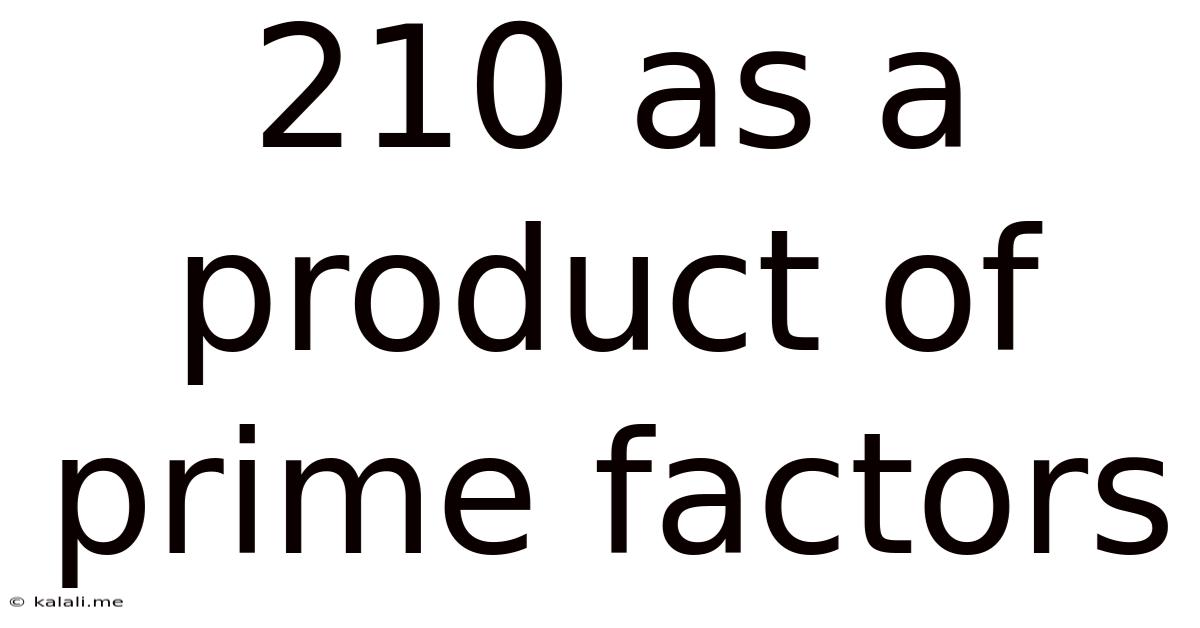210 As A Product Of Prime Factors
Kalali
Jun 11, 2025 · 3 min read

Table of Contents
210: A Prime Factorization Journey
Finding the prime factors of a number is a fundamental concept in mathematics, crucial for understanding number theory and simplifying complex calculations. This article will guide you through the process of prime factorizing 210, explaining the method and its significance. Learn how to break down composite numbers into their fundamental building blocks and gain a deeper understanding of prime factorization.
What is Prime Factorization?
Prime factorization is the process of expressing a composite number (a number greater than 1 that is not prime) as a product of its prime factors. A prime number is a whole number greater than 1 that has only two divisors: 1 and itself. Examples of prime numbers include 2, 3, 5, 7, 11, and so on. Prime factorization is unique for every composite number, meaning there's only one way to express it as a product of primes (ignoring the order of the factors).
Finding the Prime Factors of 210
There are several methods to find the prime factors of a number. The most common is the method of repeated division by prime numbers. Let's apply this to 210:
-
Start with the smallest prime number, 2: 210 is an even number, so it's divisible by 2. 210 ÷ 2 = 105.
-
Move to the next prime number, 3: 105 is divisible by 3 (1+0+5=6, which is divisible by 3). 105 ÷ 3 = 35.
-
Continue with the next prime number, 5: 35 is divisible by 5. 35 ÷ 5 = 7.
-
The result is 7, which is a prime number: We've reached a prime number, indicating we've completed the factorization.
Therefore, the prime factorization of 210 is 2 x 3 x 5 x 7. We can write this concisely as 2¹ x 3¹ x 5¹ x 7¹.
Significance of Prime Factorization
Prime factorization might seem like a simple mathematical exercise, but it has significant applications in various areas, including:
- Simplifying Fractions: Finding the prime factors of the numerator and denominator helps in simplifying fractions to their lowest terms.
- Finding the Greatest Common Divisor (GCD) and Least Common Multiple (LCM): Prime factorization is a crucial tool for efficiently calculating the GCD and LCM of two or more numbers. This is essential in algebra and other areas of mathematics.
- Cryptography: Prime numbers play a vital role in modern cryptography, particularly in public-key cryptography systems like RSA, which rely on the difficulty of factoring large numbers into their prime components.
- Number Theory: Prime factorization forms the basis of many theorems and concepts in number theory, a branch of mathematics that studies the properties of integers.
Conclusion
Prime factorization, as demonstrated with the example of 210, is a fundamental process with wide-ranging applications. Understanding this process provides a solid foundation for more advanced mathematical concepts and problem-solving. By systematically dividing by prime numbers, we can effectively break down any composite number into its prime components, revealing its fundamental structure. The simple process of finding the prime factors of 210 (2 x 3 x 5 x 7) illustrates the power and elegance of this fundamental mathematical concept.
Latest Posts
Latest Posts
-
How Do You Say Grandparents In Spanish
Jul 02, 2025
-
How Many Numbers Are Between 48 To 24
Jul 02, 2025
-
How Many Positions Are There In Sex
Jul 02, 2025
-
How Many Minutes Are In 10 Miles
Jul 02, 2025
-
How Many Milliseconds Are In A Day
Jul 02, 2025
Related Post
Thank you for visiting our website which covers about 210 As A Product Of Prime Factors . We hope the information provided has been useful to you. Feel free to contact us if you have any questions or need further assistance. See you next time and don't miss to bookmark.